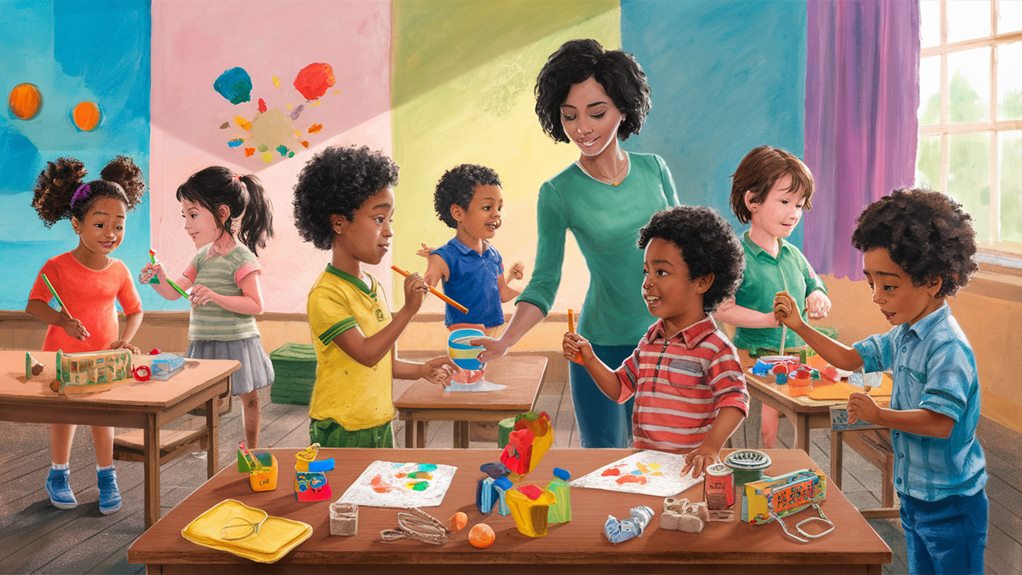When tackling challenging behavior, consider these seven creative discipline ideas. Swap time-outs for time-ins to foster emotional regulation and self-awareness. Role-playing scenarios build social skills and confidence. Natural consequences teach responsibility through real-life lessons. Use positive reinforcement, like behavior charts or verbal praise, to boost motivation. Mindfulness and breathing exercises can help calm anxiety and improve focus. Incorporate creative expression activities, like drawing or storytelling, to allow emotional release. Each approach promotes growth and connection, equipping you and your child with tools to navigate challenges. Discover how these ideas can enhance your parenting journey and transform behavior today.
Key Takeaways
- Implement Time-In instead of Time-Out to help children articulate feelings and develop self-awareness in a safe environment.
- Use Role-Playing Scenarios to teach social skills, boost confidence, and encourage problem-solving in a supportive setting.
- Apply Natural Consequences to reinforce learning through real-life experiences, fostering responsibility and decision-making without punishment.
- Employ Positive Reinforcement Techniques like behavior charts and verbal praise to motivate and connect positive actions to feelings.
- Integrate Mindfulness and Breathing Exercises to improve self-regulation, focus, and emotional resilience in children facing challenging behaviors.
Time-In Instead of Time-Out
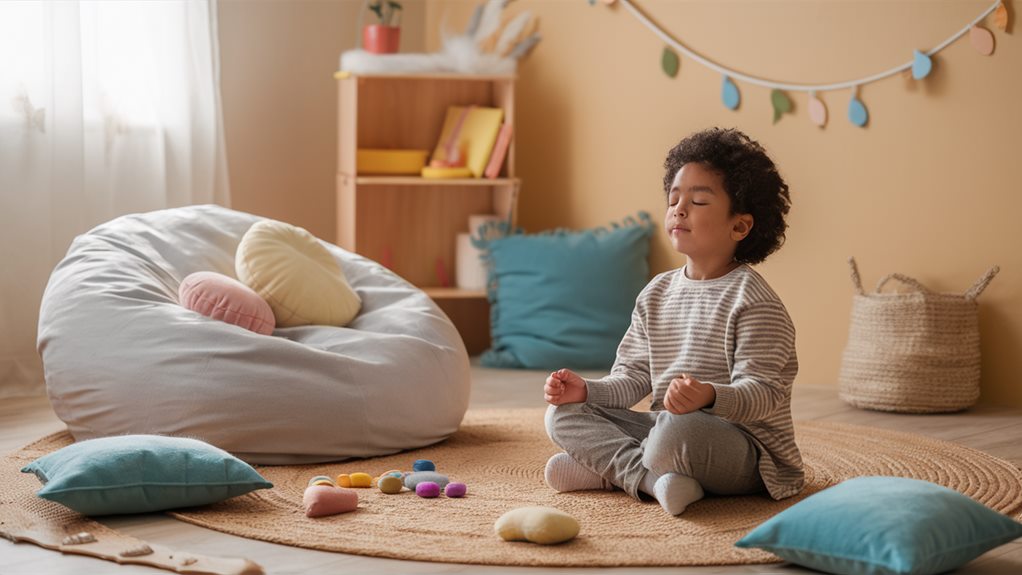
When kids act out, it's easy to resort to time-outs as a quick fix, but have you ever thought about turning that approach on its head? Instead of isolating your child during challenging moments, consider a "time-in." This method not only helps with emotion regulation but also fosters self-awareness, encouraging your child to understand their feelings better. Just like how GPS trackers enhance pet safety by providing real-time monitoring, a time-in can give children the real-time emotional support they need to navigate their feelings.
During a time-in, you create a safe space where your child can express themselves openly. Sit together in a quiet area, away from distractions, and gently guide them to articulate what they're feeling. Ask questions like, "What's bothering you?" or "Can you tell me what made you upset?" This not only validates their emotions but also teaches them that it's okay to talk about feelings.
Research shows that children who practice emotion regulation tend to develop stronger self-awareness. By engaging in a time-in, you help them recognize their emotional triggers and learn to manage their responses. This process builds resilience and fosters a sense of belonging, as they realize they can rely on you for support.
Role-Playing Scenarios
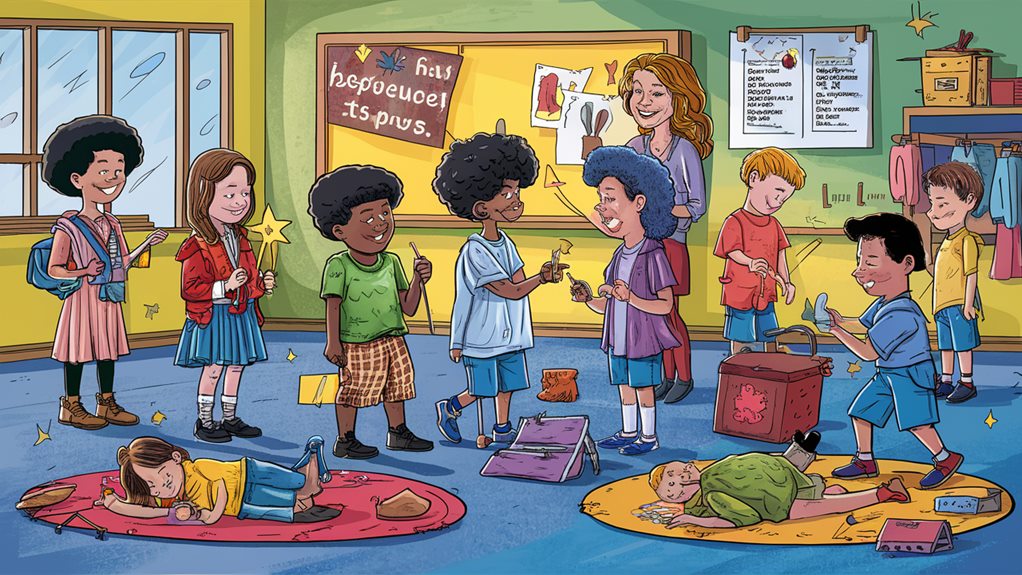
Role-playing scenarios can be a powerful tool for teaching kids how to navigate challenging behaviors and social situations. By engaging in these imaginative activities, children can practice responses to various challenges they might face, making them feel more prepared and less anxious. Additionally, much like using an ergonomic laptop stand to improve posture and comfort, role-playing enhances children's emotional and social stance through practice and engagement.
Here are three compelling benefits of using role-playing in your discipline approach:
- Skill Development: Kids can learn crucial social skills, such as empathy and communication, through improv exercises. When they step into different roles, they gain perspective on others' feelings and reactions.
- Safe Environment: Drama therapy offers a safe space for children to express their emotions and explore difficult situations without fear of real-life consequences. This can lead to breakthroughs in understanding their own behaviors.
- Increased Confidence: As kids practice these scenarios, they build confidence in their ability to handle similar situations in real life. This sense of empowerment can reduce anxiety and improve their interactions with peers.
To implement role-playing, create specific scenarios relevant to your child's experiences. For instance, role-play how to ask a friend to join a game, or how to express frustration without resorting to anger. Encourage your child to suggest solutions or responses, fostering creativity and problem-solving skills. By integrating role-playing into your discipline toolbox, you're not just correcting behavior; you're nurturing a sense of belonging and adaptability that will serve them well in the future.
Natural Consequences
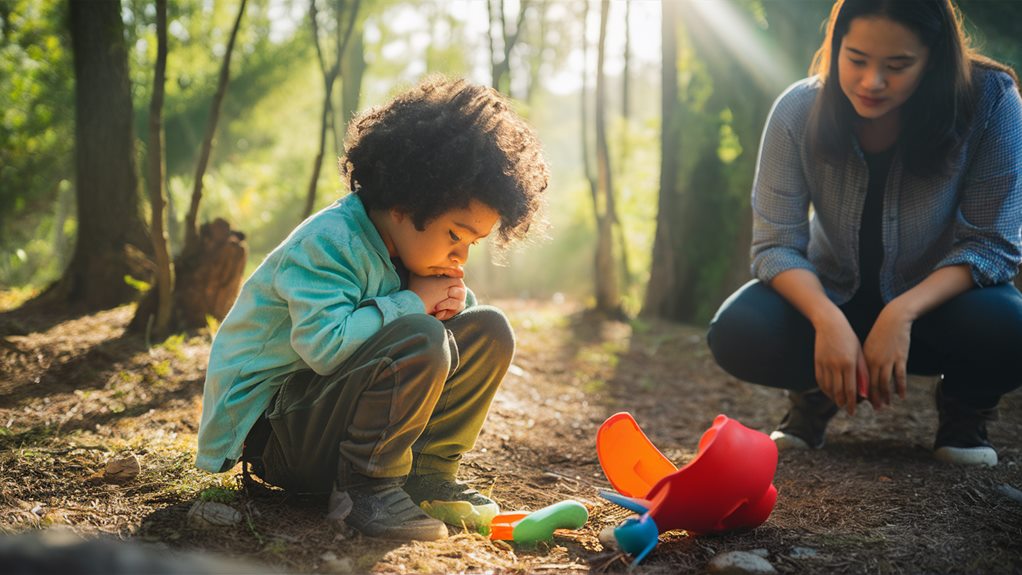
Building on the idea of equipping children with skills to handle challenging situations, natural consequences can be a powerful way to reinforce learning through real-life experiences. When children face logical outcomes as a result of their actions, they gain invaluable insights that enhance their understanding of responsibility and decision-making.
For instance, if your child refuses to wear a coat on a chilly day, let them experience the cold. While it may seem tough, this serves as a teachable moment. They'll learn firsthand that their choices have real consequences, which can prompt them to make wiser decisions next time.
Instead of imposing a punishment, you're providing a natural learning experience that fosters growth.
It's essential to approach these situations with empathy. Make sure your child knows you're there to support them, even when they're experiencing discomfort. This creates an environment where they feel safe to learn from their mistakes without fear of judgment.
You can discuss what happened afterward, guiding them to reflect on their choices and understand the reasons behind the outcomes.
Positive Reinforcement Techniques
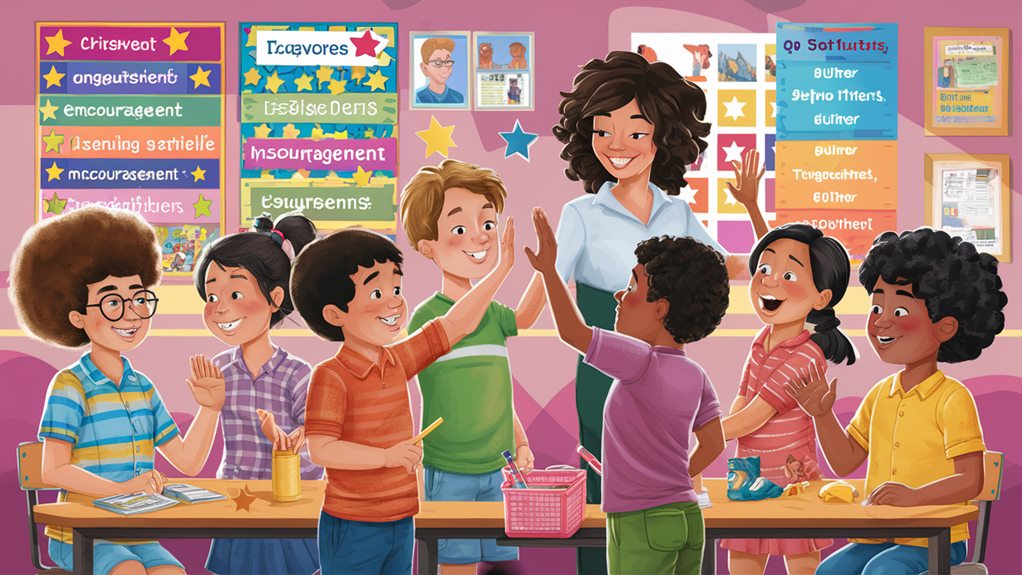
How can you effectively encourage positive behavior in your child? Using positive reinforcement techniques can make a significant difference in shaping their actions. When you recognize and reward good behavior, you create an environment where your child feels motivated and valued. Incorporating elements like soothing technology can further enhance this positive environment at bedtime, promoting better overall behavior during the day. Here are three practical approaches you can implement:
- Behavior Charts: Create a visual chart that tracks your child's positive behaviors. Each time they demonstrate good behavior, like completing chores or sharing with siblings, they earn a sticker or checkmark. Once they accumulate a certain number, reward them with a small prize or extra playtime. This not only reinforces positive actions but also gives them a sense of accomplishment.
- Token Economy: Develop a token system where your child earns tokens for specific positive behaviors. For instance, if they help with homework or exhibit kindness, they receive a token. Once they collect a certain amount, allow them to exchange these tokens for privileges or special treats. This method teaches them the value of working towards a goal while reinforcing desirable behavior.
- Verbal Praise: Never underestimate the power of words! A simple "I'm proud of you" or "Great job!" can go a long way. Specific praise, such as "I love how you shared your toys today," helps your child connect their actions to positive feelings.
Mindfulness and Breathing Exercises

Incorporating mindfulness and breathing exercises into your child's daily routine can greatly enhance their ability to manage challenging behaviors. These practices create a calm space for your child to process emotions and develop self-regulation skills. Research shows that mindfulness can improve focus, reduce anxiety, and foster emotional resilience, making it a valuable tool for both you and your child.
Start with deep breathing exercises. Encourage your child to take a moment to breathe in deeply through their nose and out through their mouth. You can guide them to count to four while inhaling, hold for a count of four, and then exhale for another four counts. This simple technique can help them regain control during moments of frustration.
Consider incorporating guided visualization as well. Invite your child to close their eyes and imagine a peaceful place, like a beach or a forest. Ask them to describe what they see, hear, and feel. This exercise not only distracts from overwhelming emotions but also helps them build a mental toolkit for calming themselves.
Collaborative Problem Solving
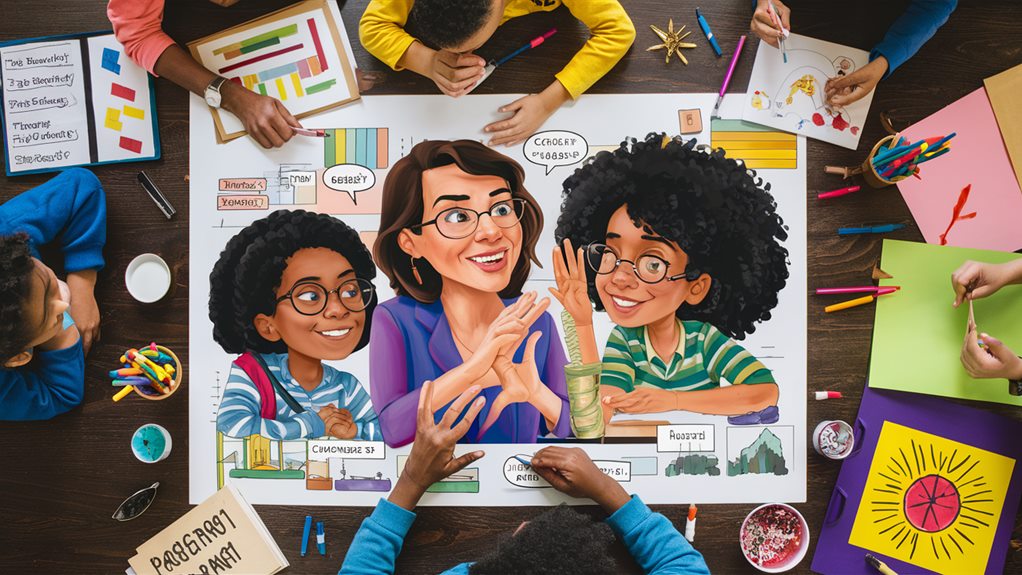
When faced with challenging behavior, engaging in collaborative problem solving can be a game-changer for both you and your child. This team approach fosters communication, understanding, and a sense of belonging, all while focusing on solutions rather than blame. By working together, you can help your child learn to navigate their feelings and behaviors in a constructive manner.
Here's how to implement collaborative problem solving effectively:
- Identify the Problem: Sit down with your child and discuss the specific behavior that's causing concern. Make sure they feel heard and validated in their feelings.
- Brainstorm Solutions: Together, generate a list of possible solutions. Encourage your child to think creatively and consider what might work for both of you. This empowers them to take part in their own discipline process.
- Evaluate and Choose a Solution: Review the potential solutions and decide on one to try. Make sure it's practical and achievable, reinforcing that you're in this together.
Creative Expression Activities
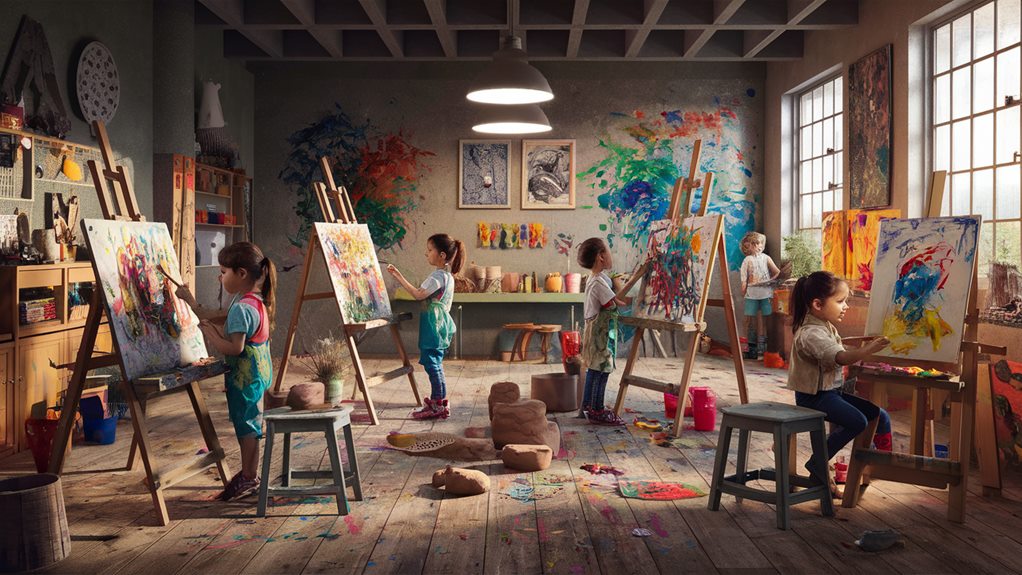
Creative expression activities can be powerful tools for managing challenging behaviors and fostering emotional growth in children. Engaging in creative outlets provides a safe space for children to express their feelings and thoughts, reducing anxiety and frustration. Art therapy and music therapy are particularly effective, as they allow kids to communicate and process emotions they might struggle to articulate verbally.
Here are some creative expression activities you can try:
| Activity | Description | Benefits |
|---|---|---|
| Drawing & Painting | Provide materials for free expression. | Encourages self-discovery and emotional release. |
| Music Making | Use instruments or apps to create sounds. | Boosts self-esteem and teamwork skills. |
| Storytelling | Encourage kids to tell or write their own stories. | Enhances communication skills and builds imagination. |
| Dance & Movement | Let children express feelings through movement. | Helps with physical coordination and emotional regulation. |
These activities not only help manage challenging behaviors but also promote a sense of belonging and community. When children see their peers engaging in creative expression, they often feel encouraged to participate, fostering an atmosphere of acceptance and support.
Frequently Asked Questions
What Age Is Appropriate for Implementing Creative Discipline Strategies?
When you think about implementing creative discipline strategies, consider that early childhood is a pivotal time for shaping behavior. At this age, kids are learning boundaries and emotional regulation.
As they move to middle school, they need more intricate strategies to navigate social dynamics. Tailoring your approach to their developmental stage can help them feel understood and supported, fostering a sense of belonging while guiding them towards positive behavior.
How Can I Involve My Child in the Discipline Process?
Involving your child in the discipline process can feel like inviting them to co-author their own story. Start by fostering parent collaboration—discuss expectations and consequences together.
Empower your child by letting them express their feelings and ideas for solutions. This approach not only strengthens your bond but also nurtures their sense of responsibility.
Are There Specific Books for Parents on Creative Discipline?
If you're looking for specific books on creative discipline, there are plenty of parenting guides that focus on behavior management. Titles like "The Whole-Brain Child" and "No-Drama Discipline" offer practical strategies and empathetic approaches. These resources can help you navigate challenges while fostering a strong bond with your child.
You'll find ideas that encourage cooperation and understanding, making discipline a collaborative process that promotes belonging within your family.
Can Creative Discipline Techniques Be Effective for Teenagers?
Yes, creative discipline techniques can be effective for teenagers. When you understand the roots of teenage rebellion and peer pressure, you can tailor your approach. Instead of strict punishments, try engaging discussions that foster trust and connection.
Encourage them to share their feelings and perspectives, which helps them feel valued and understood. This empathetic approach not only addresses their behavior but also strengthens your relationship, promoting a sense of belonging and support during these challenging years.
How Do I Measure Success With These Discipline Strategies?
Measuring success with discipline strategies is like tuning a musical instrument; you need to listen closely. Start by setting specific goals for behavior changes and track progress with behavior charts. They'll help you visualize improvements over time.
Implementing reward systems can motivate your teen, reinforcing positive actions. Celebrate small victories together, creating a sense of belonging.
Conclusion
Incorporating these creative discipline ideas can transform challenging behavior into opportunities for growth. Imagine a garden; with the right care—like proper watering and sunlight—plants flourish. Similarly, when you nurture your child's emotional needs through techniques like mindfulness or collaborative problem-solving, you help them thrive. Research shows that positive reinforcement not only improves behavior but also strengthens your bond. By embracing these strategies, you're not just correcting behavior; you're cultivating resilience and understanding in your child.

